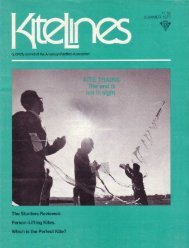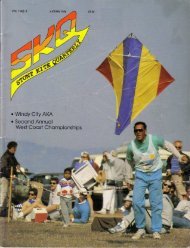<strong>Kite</strong> fishing makes sense .Why isn't it more popular?By Warren 0 . (Stormy) Weathers<strong>Kite</strong>s can provide the boatless fishermanaccess to waters that have beenheretofore available only to boats .Conversely, for boat owners, kites providea way to fish in areas where it isnot safe to take their boats ; the kite ineffect provides a half-mile long extensionto the fishing rod in the boat .<strong>Kite</strong>s can also be used for trolling whenengines are stopped, to conserve fuel .In short, kite fishing makes sense .THE BIG MOUTH &PELICAN SLEDSBy W .O . (Stormy) WeathersPaul Sroka's laterally vented sledscaled down to two feet vertically,makes a great fishing kite . Never oncehas a two-foot Sroka shamed itself orembarrassed me by collapsing ordiving into the drink .In kite fishing there are times whena two-foot kite just isn't large enough,so I scaled the Sroka kites up to fourfeet, and ran head-on into the collapsething that has plagued the larger sledkites from the beginning . Having beenled to believe that vent shape and sizewould solve the collapse problem, Ibuilt a kite on which I could tapepanels with various vent shapes andarrangements . After I had tried ventsshaped like hearts, diamonds, clubs,spades, the Maltese cross, the swastikaand the bar sinster, I concluded thatat best vents only cured the symptomsof a basic fault in the sled design .I discovered that a sled collapses forthe same reason that a flag flutters inthe wind . In a slightly gusty wind,collapse starts in one of two ways : (1)A fold about two inches wide fluttersdownward in the middle of the centerpanel's leading edge . The wind catchesthis fold, exaggerates it and slams thekite shut . Or : (2) A flutter forms aninward fold on the bridle flap's leadingedge . The wind rolls the flap under,and the whole kite rolls up, sometimesso neatly that if you slip a rubber bandaround it, you are ready to go home .Fortunately, there is a way to virtuallyeliminate these two modes ofcollapse ; you merely angle the sticksinwards towards each other from topto bottom . In other words, you givethe kite a big mouth .Angling the sticks this way reducesthe chance of the covering materialbecoming parallel to the wind, aposition that causes flutter to develop .The big mouth scoops in enough air tobuild up a slight pressure inside thekite, which also helps to prevent flutter .As a result, the forms of collapse describedare no longer much of a problem .Why isn't it more popular? Many reasons,but probably the biggest is thememories of kites we flew as kids . <strong>No</strong>bodywas likely to try fishing with oneof those, and if he did, he wouldn't trya second time . <strong>Kite</strong> fishing with oneof the 39¢ kites requires that the kitefisherman be more skilled as a kiteflierthan as a fisherman .But things have changed . Thanks tothe improved kites both on the marketand out of the home workshop, flyingcan be done in winds from about sixknots to around 36 knots . My ownchoice is a sled-type kite made fromwaterproof polyethylene sheeting(trash bag) . The kite rolls up neatly forMATERIALS• 1/8" diam . hardwood dowels• 3/4 " masking tape• 1/2" strapp ing t ape• Plastic trash bag, size as needed . (Forlarger kites you can split a bag downone side and across the bottom to geta double-size cover .)INSTRUCTIONSPrepare CoverLay the pattern out on paper first, asfollows : Fold the paper along thecenter line, making sure the fold isat right angles to the top (match thefolded halves) . Draw half your pattern,then draw a pattern inside thefirst, but % " smaller on all sides . Youshould now have the half pattern out-
.storage and transportation (I use aplastic golf club tube) and requires noon-site assembly. Furthermore, it iseasy and inexpensive to build and asnap to fly.The fisherman can either use a verysmall kite and fish with an artificial flyor grasshoppers in season, or use amedium-size kite (about 2 1/2 feet) andtroll with Ford Fenders or other rigsof his choice . The basic kite-fishingkit should include one each 2-foot, 2 ½-fo ot and 3-foot kitesThe general rule is : use the smallestkite that will do the job . It is no funto fight both a fish and a big kite in astrong wind . For very strong winds,lined with two sets of lines % " apart .Take scissors and cut out the smallerpattern, both halves at once to insuresymmetry. Unfold the pattern and layit on the covering material (trashbag) . Outline the pattern with strappingtape split into % " widths . Getthe tape as close to the pattern aspossible, but avoid sticking it ontothe pattern . Lift the pattern off andtrim off the excess covering materialoutside the tape .Attach SticksLay the dowels on the pattern as shown .Secure them with throe or four bits ofmasking tape to hold them in place,then cover the entire length of thedowels with % " masking tape . Carefullyput on the crosswise piece ofstrapping tape, leaving six inchesWard Weathers, 8, and Benjamin Weathers,5, compare the relative merits of ventingand paper-cup stabilizers on a couple offour-foot Bigmouth prototypes . Which kiteis flying cross-wind, and why doesn't itcollapse as the good book says it will?build one two-foot kite with 3/16-inchdowels . These are a little heavy andtend to be unstable in light winds, butin strong winds they do quite well .When fishing in light breezes use athree- or four-foot kite . As wind picksup, switch to a smaller, heavier kite .Line used is 30- to 40-pound testmonofilament . For true kite fishing,a rod is not used, just a large fishingor kite reel . Of course, I recommendthe Weathers Mono-winch <strong>No</strong> . 6M kitereel, which will hold a mile of 30-poundtest line .There is a problem where the prevailingwinds are on-shore . If you planto fish under these conditions, seekextra on each side . Cover the excesstape with a 2x 1/3" piece of paper positionednext to the cover .Attach BridleTake a piece of bridle line four timesas long as the kite . Fold a 4" bight andtie an overhand knot in each end sothat a loop about 1" long is formed .Slip this loop over the bridle looptabs, fold the tab at the middle of the2" piece of paper, and stick the tab tothe back side of the kite, forming thebridle loop . Fold the kite along thecenter line, holding bridle cornersaligned face to face, and draw bothlegs of bridle between thumb and forefingerso that the two legs are evenedup . When you are sure the bridle legsare equal, tie an overhand knot about1" in from the towing point . Use a snapswivel to attach the flying line .Go FlyingIf the kite loops or dives to one side,check the bridle by turning the kiteinside out to see if it pulls in the oppositedirection . If it does, haul the kitein, and unstick the bridle loop on theside towards which the kite was pulling .Restick the tab so that the loop is about1/4" shorter, and put the kite up again .If you run out of adjustment on oneside of the kite, you can lengthen theloop on the other side to achieve thesame effect . Repeat until the kite'smedian position is upright .Further ExperimentsI don't normally vent the Bigmouth,but when I do my preference is forrectangular or parallelogram vents1/6th the kite height in length and1/24th in width (a 1 :4 ratio) . The ventsout jetties, piers, spits and peninsulas .High lakes are another good spot forkite fishing .On the larger rivers it is sometimesmore difficult to kite fish because ofodd wind currents and eddies set upby high banks and bordering trees .But it can be done . Use the smallestkite that will work satisfactorily, sincesmaller kites are less affected by eddiesthan big kites . When you go fishing ona river, take a selection of kites rangingin size from six inches to three feet inheight . A six-inch kite will be hard tofind for sale, so inveterate kite buyersmay have to capitulate and make theirown kite for this . (System continued)start at the sticks at a distance equalto 2/3rds the length of the vent from thebottom of the kite and angling upwardstoward the center at about 45degrees . I've also used paper cupswith their bottoms removed taped tothe base of each stick as stabilizers .Eight-ounce cups work for four-footkites .For a fishing kite, I wanted a lowerlift/drag ratio, so I modified my Bigmouthusing Paul Sroka's bridle points,which are 5Y2% lower and 5Y2% fartherout (using the height of the kite as thebase of measurement) from the centerpanel than are the Scott and Allisonbridle points . If you need a kite forpulling something, use the dimensionsfor the Pelican fishing kite .Both kites fly at elevation anglesfrom about 35 to 55 degrees, thoughthey will occasionally go almoststraight overhead . If you want to makethe kites fly at a higher angle, take acouple of half-inch tucks in the leadingedge of the center panel . Taper thetucks neatly back into a V shape aboutsix inches long, and hold them in placewith masking tape . The tucks result ina somewhat airfoil shape and an increasein lift .As for scaling the kites up or downfrom the sizes given, I have scaledthem up to four feet and down to sixinches (using broom straws as sticks,attached with bits of cellophane tapeon light plastic, and leaving off thestrapping tape-the kites are weightsensitive) . Larger Bigmouth kitesshould behave themselves well, butsomewhere around eight feet a thirdstick should be added down the centerline to keep flutter out of the leadingedge of the center panel .
















